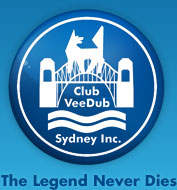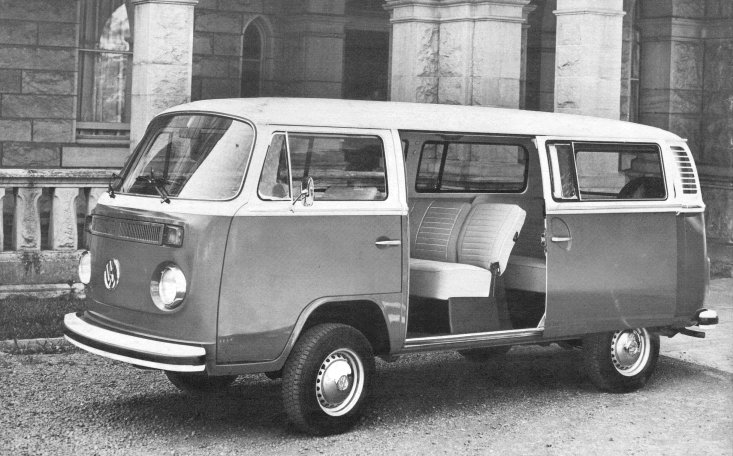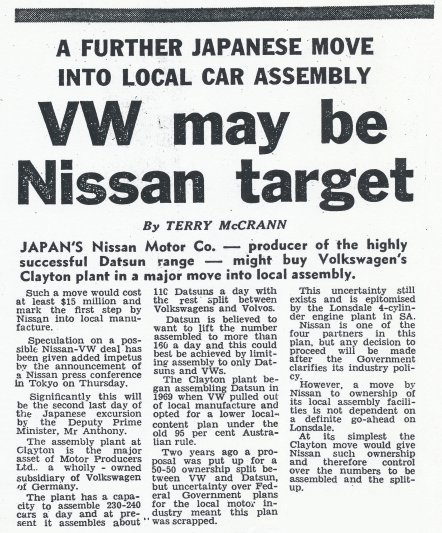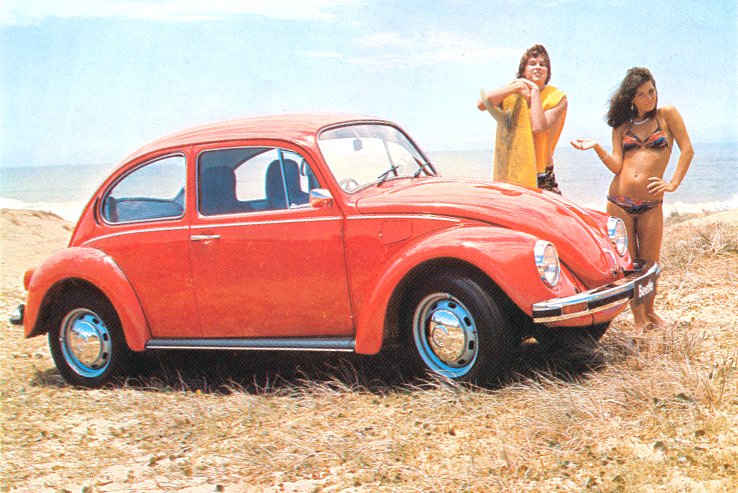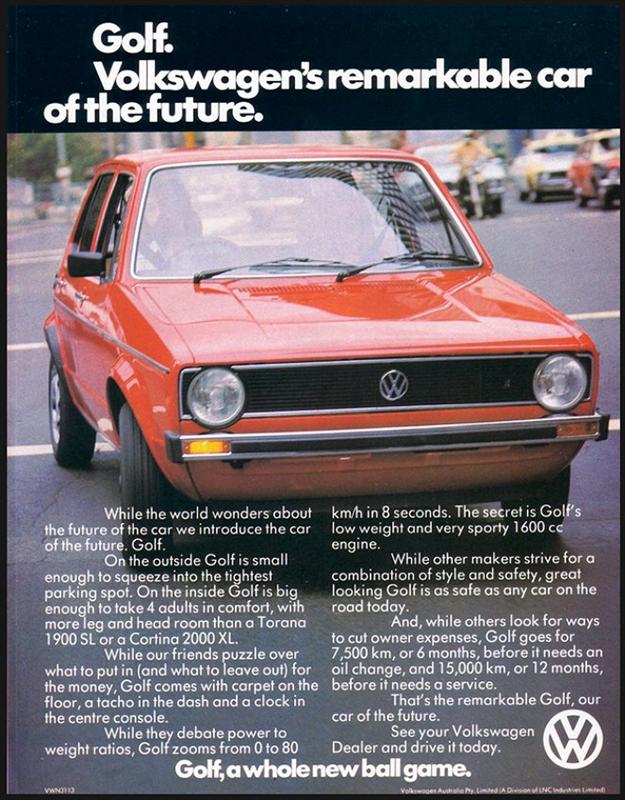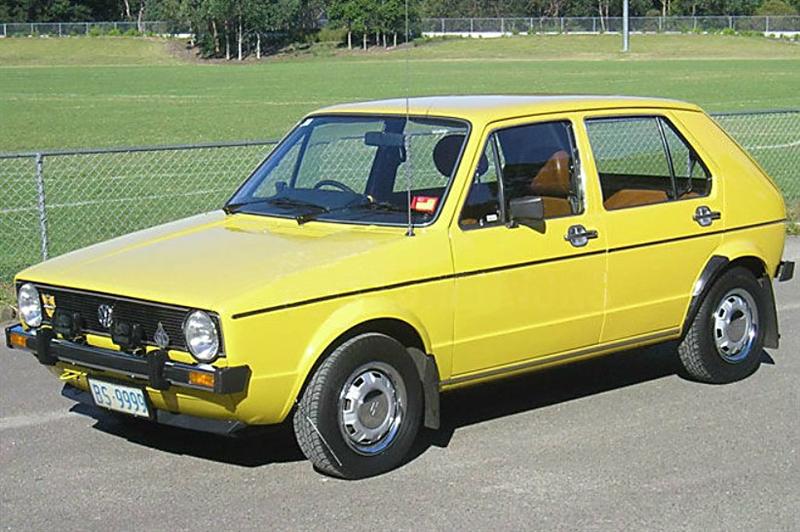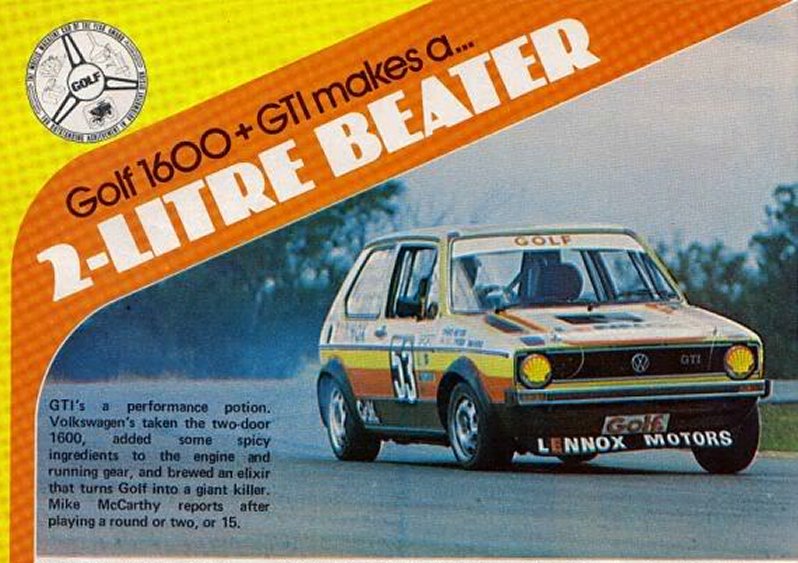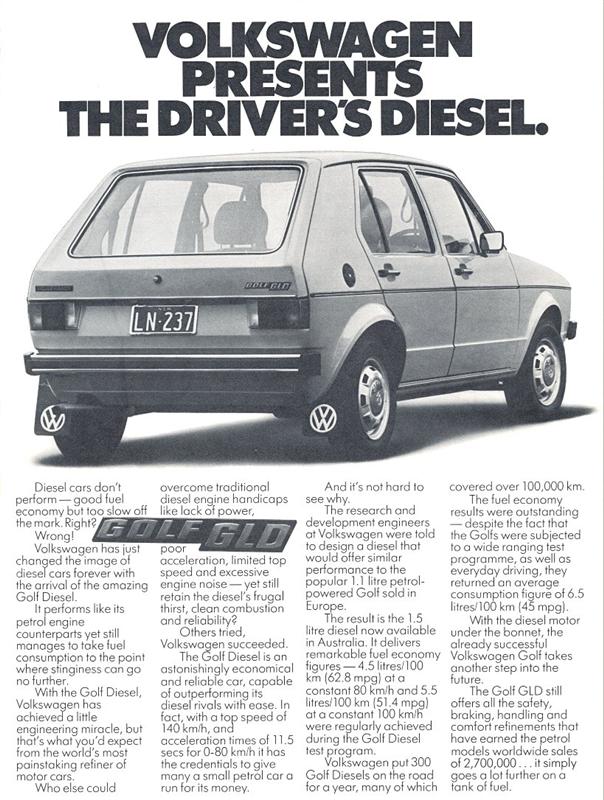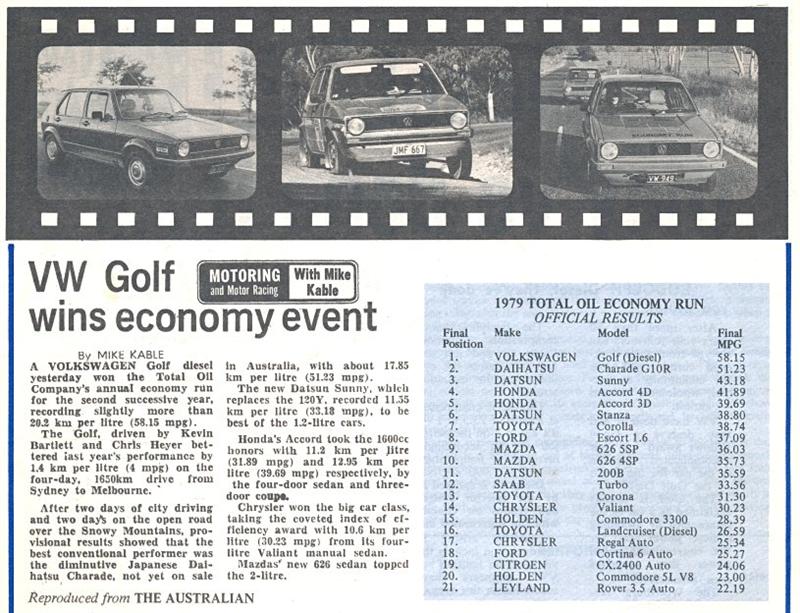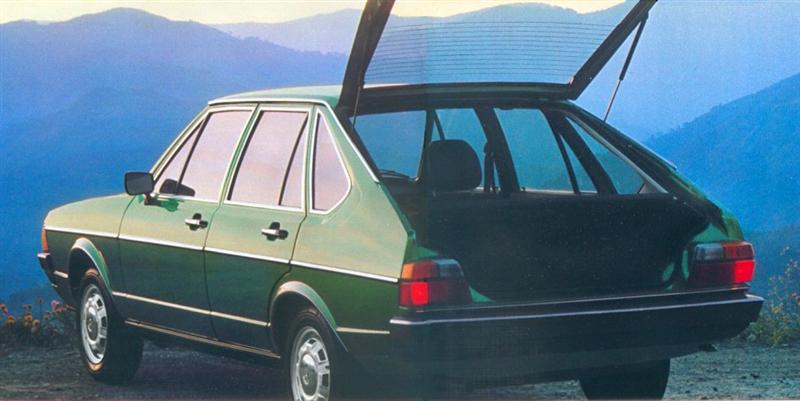1975 - 1979
Australian Volkswagen History
1975
Lanock Motors (South Coast), previously a separate Wollongong-based LNC company, is merged completely with the Sydney-based Lanock Motors Limited. The Larke Hoskins business is financially merged with Lanock Motors, but continues to trade under their own name. VWs are sold through Larke Hoskins dealerships in Miranda and Bondi Junction, while Renaults, Fiats and Hondas are added to Lanock Motors dealerships.
LNC signs a $2 million contract to supply more VW Transporters to the Australian Army. These are supplied with upright 1600cc engines and manual gearboxes, in semi-matt olive green with basic brown vinyl seat upholstery.
The inflation problems of the early 1970s under the Whitlam Government hit car prices across the market. The Superbug’s price has risen to $3,648; the Passat 1300 to $4,075; the Passat 1500 to $4,561 and the TS Passat to $4,667. The basic 1600 Kombi is $4,513, the 1800 Kombi is $4,912 and the 1800 Microbus is $5,396. The most expensive model in the local range is the Audi 100GL, starting at $8,195. This compares with $3,129 for a Mini S, $4,643 for a Holden Kingswood and $5,701 for a Holden Premier.
Both Beetles continue largely unchanged. In June the last German update CKD kits for the Superbug L arrive and it receives rack and pinion steering and a charcoal canister. The front blinkers are moved from the mudguards to the bumper, while the rear apron is bulged for the US-spec catalytic converter (which was never fitted). The 1300 Beetle is discontinued, and the first Golf CKD packs are imported for evaluation and assembly on the former 1300 Beetle’s production line. Assembly of the Golf begins late in the year once the line has been converted, but due to delays and shortages of components, the Golf’s release onto the market is postponed until the new year.
The Superbug L is discontinued in November, as the model has been discontinued in Germany and the CKD kits are no longer available. The solitary Beetle model to continue into 1976 will be a ‘bitsa’ known as the ‘1600 Beetle’.
The Transporter receives some minor improvements to the controls and seats. The 1975 model proved to be the biggest-selling year for the faithful VW Kombi in Australian history; 8,974 Kombis (including Microbuses) is more than Toyota’s Hiace or Hyundai’s iLoad today! The Kombi captures 43% of the Australian 1-tonne van market.
Race driver Chris Heyer enters the only VW in the Bathurst Hardie Ferodo 1000 – a VW Passat - co-driven with Barry Allen. This time they elect to compete in the below-1300 cc Class A, rather than be disadvantaged with a 1500cc car in the 1301-2000 cc Class B, so they enter with a 1300cc two-door Passat. Unfortunately it broke its camshaft after just 57 laps.
Nissan/Datsun decide to enter the Government’s 85% local content plan, which would require converting the Clayton plant back to full manufacturing. Volkswagen Germany was still the plant owner and did not wish to make any new investments, including turning down a serious proposal to fully manufacture the new Golf in Australia (as the Uitenhage VW plant in South Africa would soon be doing). Urgent discussions between Nissan Motor Japan and the Volkswagenwerk in Germany in October result in Nissan agreeing to buy the whole share capital of Motor Producers Ltd, and the entire Clayton factory. The Australian management team were advised immediately but had no input in the decision.
Nissan confirms that Motor Producers Ltd would continue for the rest of this year, but would come under Japanese control early next. Local assembly of CKD Volkswagens would continue at Clayton, but under Nissan’s control from April 1976 onwards.
Volkswagen Australia’s management quickly began detailed discussions with the Chairman of the Volkswagenwerk, Toni Schmuecker, as well as senior executives of Nissan Motor Japan. It was made clear to the Australian management that, despite the sale of Motor Producers Ltd, VW AG would continue the supply of VW product (both CKD kits and complete cars) to retain Volkswagen’s current position in the Australian market.
15,479 Volkswagens are sold – 462 VW 1300s, 1,930 VW 1600s, 4,113 Passats and 8,974 Transporters.
1976
The former Volkswagenwerk-owned Motor Producers Ltd comes under the control of Nissan in March, and the company is closed down. Nissan, and its Australian-Japanese management team, take total ownership and control of the former Volkswagen plant. Nissan retains most of the ex-VW workers, as VWs continue being assembled at the plant but now making up only two-fifths of the total output.
The ‘1600 Beetle’ debuts, basically an updated 1300 Beetle from the previous year, fitted with leftover parts from the Superbug. Torsion bar front with disc brakes, rear is ex-Superbug 1600cc twin-port alternator engine with double joint rear axles. It has chrome bumpers with rubber inserts and blinkers, black wiper arms and ‘elephants foot’ taillights. For the first time there is no VW badge or logo anywhere on the car, except on the hubcaps. It’s also the first (and only) time the car is officially sold as the ‘Beetle.’ It retails for $4,140.
The Golf is released onto the market in March, joining the Passat as the second water-cooled VW model sold in Australia. Locally assembled by Nissan at Clayton alongside the Passat, 1600 Beetle and Transporter, it is released in 1600cc ‘LS’ form only, in three or five-door manual, or five-door auto versions. The remarkable Golf has more leg room than a Torana, more head room than a Kingswood and more performance than a 250 cu.in. Falcon, in a package shorter than a Datsun 120Y. In no time there is a lengthy waiting list, with buyers waiting up to six months for delivery. The Golf is named Wheels Magazine’s Car Of The Year, VW’s second such award in three years. The Golf starts at $4,360 for the 3-door, and $4,490 for the 5-door.
LNC Industries imports at least two Sciroccos for local evaluation, and displays one VW coupe (in metallic silver) at the Sydney Motor Show. Another metallic silver Scirocco (NSW plates HSP-666) is made available to the press for testing. However, with an expected retail price of around $7,000 (compared with $4,900 for a Toyota Celica), it proves too expensive and is never released for sale in Australia.
The low-volume two-door Passats, the 1300 and 1500TS, are discontinued. The four-door LS sedan and wagon continue, with the engine enlarged to 1600cc, same as the Golf, and the gearshift linkage much improved. Prices start at $4,990.
The Transporter’s twin-carb engine is bored and stroked to 2000cc and 51 kW. It is now the only engine choice, as the old upright 1600cc engine and previous 1800 twin-carb engine are both discontinued.
The Government introduces Australian Design Rule 27A, which sets tough new exhaust and evaporative emission limits for all new cars sold from July. Golfs and Passats receive carburettor, ignition and exhaust gas recirculation modifications, and extra parts and plumbing. Transporters are fitted with L-Jetronic fuel injection and similar extra parts. However, LNC decides it is not economic to make the expensive modifications required on the low-selling local Beetle at the end of its life. Nor was there any thought of importing fuel-injected German-made Beetles, as these too were being wound down (and would end in January 1978). Any imported Beetles would also incur import tax duties, making them more expensive than the locally made and far superior Golf.
The Beetle 1600 therefore ceases assembly on 15 July, when the 260,055th and very last Australian-made Beetle rolls off the Clayton line, in a sad little ceremony featuring VWA’s former Australian management gathered together for the last time. There is a still sufficient stock of completed Beetles for sales to continue for the rest of the year, and shortly into the next.
Two VWs take part in the Hardie Ferodo 1000. The 1300cc Passat returns once more, this time entered by Blackwood Cars Pty Ltd and driven by Bernie Stack and Keith Poole. It fails spectacularly with a broken wishbone after just 19 laps. There is also a solitary two-door Golf, sponsored by Lennox Motors (Parramatta and Blacktown), and driven by Chris Heyer and Peter Lander. This was not a German GTI, but an Australian 2-door LS with some German GTI parts fitted. It was intended to race with the German GTI’s 82 kW heron-head engine but CAMS’ 2,500 production run homologation rule could not be met, so the Golf ran with a tuned but well-worn standard spec engine. It is entered with #53 (just like Herbie). Unfortunately it breaks a cam belt and retires after just 38 laps, so both VWs do not finish.
Buoyed by the Golf’s racing potential, Lennox Motors make plans to import and sell Golf GTI suspension parts, and together with other VW dealers they pressure LNC Industries into importing the GTI for Australian sale. LNC weigh the pros and cons, but calculate that with the import duties the GTI would be almost double the price of a locally-made LS. The original Golf GTI is therefore never sold in Australia.
The 400,000th Australian Volkswagen is sold in September, but no official ceremony marks the occasion and it passes unnoticed.
15,731 Volkswagens are sold – 1,159 VW 1600s, 4,429 Golfs, 3,945 Passats and 6,198 Transporters.
1977
After production management issues, rising costs and various supply and quality control problems at Clayton under Nissan’s control during 1976, LNC Industries announces that all Volkswagen assembly in Australia will cease from March. All Volkswagens for Australian sale will henceforth be fully imported. LNC stresses that the German factory will provide enough product to maintain existing sales levels and business for dealers. The entire range is updated and freshened, with the German vehicles a vast quality improvement on the Nissan-built VWs. All VWs are now covered by a new 12-month, unlimited distance warranty. Prices, however, rise by around 20% across the range.
The last Australian Beetle is sold in March, as the unwanted 1976 stocks finally run out. The very last Martini Olive Beetle is preserved by the Cusack dealership in Canberra, who lock it away in a storage facility and show it only rarely. It was eventually sold to the Hamilton family (Porsche dealers) in the 1990s, and is today preserved by a Melbourne VW collector in as-new, never registered condition, with less than 150 km on the speedo.
The Australian LS Golf is replaced by the fully imported German GLS, with 53 kW 1600cc engine, in three and five-door, manual and auto versions. Apart from being much higher quality and more plush, they have a modified front bonnet, chrome hubcaps, intermittent wipers and a lockable fuel cap. The luxury top-of-the-range GLS is the only model imported; the cheaper GL and L models are not considered, and neither is the sporty GTI (currently only available in LHD anyway).
The locally assembled LS Passats are also discontinued, and replaced by the fully imported luxury German GLS. It is available in 1600cc two and four-door sedan versions, auto and manual. There is no station wagon version just yet.
The Transporter is also now fully imported, in twin-carb 2000cc form. Panel Van, Kombi, Pickup and Microbus versions are imported, but are now considerably more expensive than the Japanese alternatives. LNC changes the focus of their Motor Caravan Holdings division to converting all makes of vans, due to the higher prices and much-reduced numbers of VW Transporters now available. Over 12,000 factory Campmobiles have been built so far, the largest selling campervan in Australian history.
Sales for the fully imported range drop by 54% from 1976; that is, by more than half. Volkswagen is overtaken by Volvo and Subaru and drops out of the top ten selling brands, for the first time since VW’s introductory year of 1954. VW is now in 11th.
Chris Heyer and the Lennox Motors Golf GTI return to the Hardie Ferodo 1000, this time sharing the drive with VW AG’s top test driver Rudi Dahlhauser. The number 53 Golf was damaged in practice but was repaired in time. It raced well on the day until it expired after 62 laps and did not finish. This is the year of the Moffat-Bond Falcon Hardtop formation 1-2.
After winning the Southern Cross Rally five years in a row in Mitsubishi Galant/Lancers, champion driver Andrew Cowan switches to a factory rally Golf GTI especially imported from Germany. Unfortunately it retires with a broken gearbox. The rally is won by Rauno Aaltonen in a Datsun Stanza.
6,504 Volkswagens are sold – 130 VW 1600s, 2,831 Golfs, 1,150 Passats and 2,393 Transporters.
1978
The last of the Volkswagen parts, tooling, jigs, machines, signage, files, documentation and records are removed from the Nissan plant in Clayton. The most valuable stuff is trucked up to LNC’s parts headquarters in North Ryde in Sydney, but most is dumped at the Dandenong rubbish tip.
Nissan rebuilt, renovated and updated the factory considerably over the years following; the original 1960s walls were all that remained of VW’s tenure by the late 1980s. Nissan would continue to manufacture Datsuns, and later Nissans, at Clayton until 1992, when they pulled out of Australian manufacturing and sold the site after years of hefty financial losses. Nissan lost over half a billion dollars on Australian production by the time they closed. Today the former Volkswagen factory is a subdivided industrial estate, and includes a large Linfox depot, industrial printers and the headquarters of Holden Special Vehicles. There is still one permanent reminder – on the western boundary of the site is Kombi Road.
The fully imported Golf GLD Diesel is introduced, with a 38 kW 1500cc diesel engine. It is the first diesel-engined Volkswagen to be sold in Australia, and turns the local concept of economy cars on its head with almost unbelievably low fuel consumption. Racing driver Kevin Bartlett drives a demonstration model from Sydney GPO to Melbourne GPO at an average of only 3.62 litres/100 km fuel consumption. The Golf Diesel also wins the Total Oil Economy Run, driven by John Leffler, averaging 4.8 L/100 km. The Golf Diesel starts at $7,759, $450 more than the petrol equivalent.
The Federal Government reduces the Volkswagen import quota to less than 10,000 vehicles per year, as there are no longer any offsets gained from local assembly. Prices for the fully imported VW range continue to rise alarmingly. Sales drop by 35.5% and VW slips to 12th, passed by Mercedes-Benz.
LNC Industries rationalises their franchises, removing Jeep, Kawasaki and Rambler from their portfolio and taking on Alfa Romeo, Peugeot and Volvo Penta. There is consolidation of the dealer network, with former Volkswagen-only dealers now selling Subarus, Hondas, Fiats, Lancias, Renaults and Audis.
The Lennox Motors Golf GTI, number 53, returns to the Hardie-Ferodo 1000 for the third time, driven again by Chris Heyer and Rudi Dahlhauser. In spite of a size disadvantage against the RS2000 Escorts in the Under 2-litre Class C, the Golf reaches as high as third in class in early racing. However it expires on lap 36 with a broken throttle linkage.
4,196 Volkswagens are sold – 2,364 Golfs, 356 Passats and 1,476 Transporters.
1979
The Fraser Government’s budget adds an additional 12½% duty on imported cars, which LNC passes on as an ever-higher retail price on the imported Volkswagen range. Demand for the economy champion Golf Diesel is particularly high but sales are hampered by limited stock and a price almost twice that of the equivalent Holden Gemini diesel.
The Golf’s emission equipment is improved, increasing performance. Other updates include energy-absorbing bumpers, self-adjusting rear drums, new velour and leatherette trim and a black band between the taillights.
A pair of Golf Diesels are driven across Australia, from Brisbane to Sydney, Melbourne, Adelaide and Perth (5,500 km), by Kevin Bartlett and John Leffler. The two Golfs average 3.6 and 3.7 litres per 100 km for the entire trip, averaging around 65 km/h. Kevin Bartlett and Chris Heyer also drive the Golf Diesel to win the Total Oil Economy Run, for the second year in a row, with a winning result of 4.85 L/100 km.
In February the Passat gets a new wedge-shaped front-end treatment, with four round headlights, relocated indicators and larger bumpers, lowering wind resistance and improving economy. At the rear the boot is now extended into a large hatchback, and the taillights are now lozenge-shaped, rather than rectangular. The wagon version rejoins the range. In December a Diesel version of both the sedan and wagon is released, with the same 1.5-litre 38 kW engine as the Golf diesel and the same updated luxury body and trim. Petrol Passats start at $9,900, and Diesels at $12,600 – both considerably more than the basic 6-cylinder Holdens and Fords of the time.
The first complete ‘Round Australia’ Trial since 1958, the 1979 Repco Reliability Trial, is run. At 20,000 km it is much longer than the 1950s trials, with many special competition stages. Only one VW is entered, by champion race driver Larry Perkins of Cowangie, Victoria, in his home-built ’63 Beetle. In spite of the fantastic historical connection – Larry is the son of ‘50s VW trials driver Eddie Perkins – his VW is novelty value only and ignored by the press. Peter Brock is the star. No modern VWs are entered. 185 cars start but only 13 cars finish the entire route – none of them VWs. The event is swept 1-2-3 by the HDT Commodores of Peter Brock / Matt Phillip / Noel Richards; then Barry Ferguson / Wayne Bell / Dave Boddy, and Shekhar Mehta / Rauno Aaltonen / Barry Lake.
The Hardie-Ferodo 1000 classes are rearranged, with a new Under 1600cc Class D that should suit the evergreen Lennox Motors Golf GTI. Chris Heyer returns, this time with Peter Lander, but are assigned number 73 instead of 53. It proves the most successful race yet for the Golf, finishing the race with 111 laps and sixth in class behind four Geminis and an Escort. The Golf is 28th overall, behind the winning Brock / Richards A9X Torana.
The last shipment of T2 VW Transporters arrives in Australia in November, as the model has now been discontinued and replaced by the new T3 model in Germany. An even bigger drop in sales (-38.7%) and VW slips to 14th, passed by Renault and Daihatsu.
2,572 Volkswagens are sold – 1,924 Golfs, 90 Passats and 558 Transporters.
